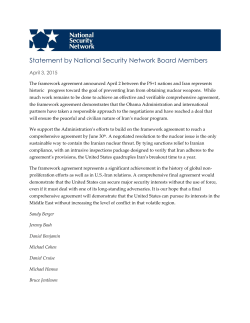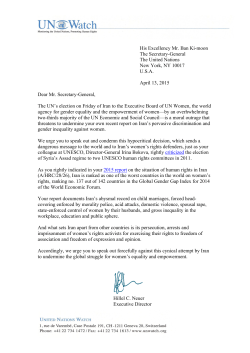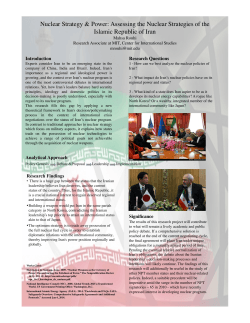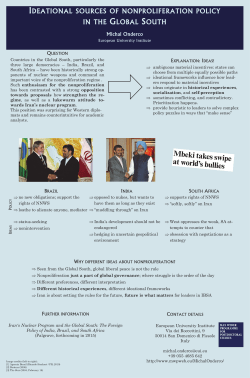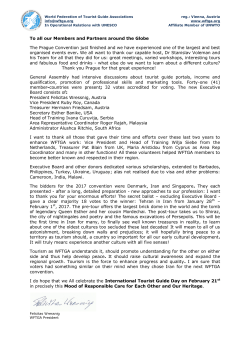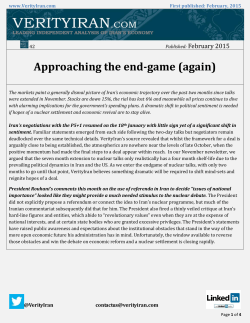
IRAN-US NUCLEAR DEAL - Institute of Strategic Studies Islamabad
INSTITUTE OF STRATEGIC STUDIES web: www.issi.org.pk phone: +92-51-920-4423, 24 fax: +92-51-920-4658 | Issue Brief IRAN-US NUCLEAR DEAL June 05, 2015 Malik Qasim Mustafa, Senior Research Fellow, ISSI © ISSI 2015 • All Rights Reserved 1|Page IB IRAN-US NUCLEAR DEAL June 5, 2015 A decade long international efforts, especially by the P5+1 (US, Russia, China, France, UK, plus Germany), to ensure that Iran’s nuclear programme will be used only for peaceful purposes, are expected to be materialise into a final long-term Joint Comprehensive Plan of Action (JCPA) by the end of June 30, 2015. After several round of talks between the P5+1 and Iran, on April 2, 2015, in Lausanne, Switzerland, both sides have agreed to key parameters of JCPA. A successful implementation of these key measures holds the potential of restoring Iran’s relations with key western nations, including the US and lifting of economic sanctions on Iran. According to the JPCA, some of the key parameters are following; Iran has agreed to reduce 19,000 installed centrifuges to 6,140, and will not enrich uranium over 3.6 percent for at least 15 years. Iran will reduce its current stockpile of about 10,000 Kg of low enriched uranium (LEU) to 300 kg for 15 years, and will not build any new uranium enrichment facility. Iran will convert its Fordow facility to be used for peaceful purposes, and will not enrich uranium at this facility for at least 15 years. Iran will only enrich uranium at Natanz for ten years, and the International Atomic Energy Agency (IAEA) will have regular access to all of Iran’s nuclear facilities. Iran will receive relief in sanctions, if it verifiably abides by its commitments. Even after the period of limitations on Iran’s nuclear programme, it will remain a party to the Nuclear Non-Proliferation Treaty (NPT); its adherence to the Additional Protocol will be permanent; and it will maintain its transparency obligations. Major western powers view this development as a decline of threat of Iran becoming another nuclear weapon state. Israel has cautiously welcomed this deal, and is hoping that a final agreement by June 30, will clarify the position of Iranian nuclear programme. The IAEA has also welcomed the Iran agreement on key parameters of JCPA, and expressed its willingness to fulfil its role in verifying the implementation of this deal. The P5+1 and Iran are trying to resolve the gaps between different parameters of JCPA, especially over the inspection of the IAEA of Iranian military basses. Iran has agreed to make deep cuts in its nuclear programme and agreed to place its nuclear programme under the IAEA inspections. However, it is concerned over the © ISSI 2015 • All Rights Reserved 2|Page IB IRAN-US NUCLEAR DEAL June 5, 2015 time and pace of lifting of international sanctions. The Obama Administration is also preparing itself to face one of the toughest challenges to get a supportive vote in Congress, once the deal is finalised. During the latest round of talks, both sides have expressed satisfaction over the progress made so far. Secretary of State John Kerry has said: “…genuine progress” has been made. So far a close review of commitments made under the November 2013, interim Joint Plan of Action (JPA), clearly shows that neither side seems to have violated any provisions of the interim agreement. Open source information establishes that Iran has completed the most of the obligations set by the interim agreement; halted enrichment of uranium above 20%: ceased operation of its centrifuges beyond 5%; converted half of its 20% enriched uranium stockpiles into uranium oxide powder. It is also in compliance with the International Atomic Energy Agency (IAEA) on related safeguards measures, and shared information on existing and future peaceful nuclear related tasks. Despite concerns over long delays in negotiations, it seemed that the deal over Iran’s nuclear programme is very close. The positive momentum in recent weeks followed public bickering and accusations regarding the agreement. The US Administration has been facing strong criticism and opposition from, among others, Israel. It was facing a split over the future of a deal. This situation was aggravated by a letter from 47 US Republican Senators warning Iran, that such a deal without approval of the US Congress was merely an executive agreement which can be revoked by the next US president with the stroke of a pen and future Congresses could modify the terms of an agreement at any time. Secretary Kerry has termed the letter as incorrect. The US was determined to go ahead with the deal despite the objectives raised by the letter. Iran too seemed to be willing to clinch the deal. The Iranian Supreme Leader, Ayatollah Khamenei, termed the Senator’s letter as a “sign of declining political ethics.” Iran also argued that if a deal was signed then any revisions in future would be a “blatant violation of international law.” The P5+1 deal is a good agreement, if it goes through. It is likely to have a positive impact on peace and stability in the region. The deal could have a positive spin-off for the situation in the Middle East as Iran and the US would collaborate to oppose the forces of violent extremism and © ISSI 2015 • All Rights Reserved 3|Page IB IRAN-US NUCLEAR DEAL June 5, 2015 terrorism, because of general reduction in tensions. There may also be good economic dividends for the entire region. That said, the agreement has made the Arab world resistive and nervous especially after the escalation of conflict in Yemen. If the deal goes through, the best way to maximize its benefits would be to reduce the tensions between the Arab countries and Iran. The US-Iran rapprochement must be matched by an Iranian-Arab rapprochement. © ISSI 2015 • All Rights Reserved 4|Page
© Copyright 2025
